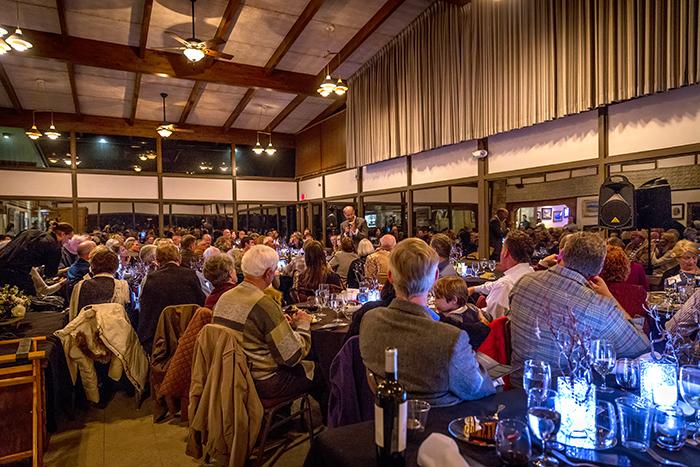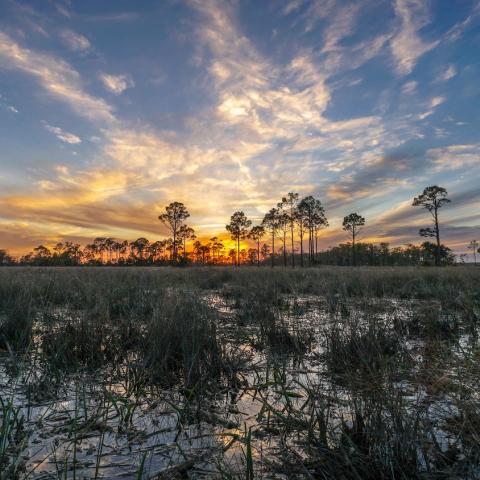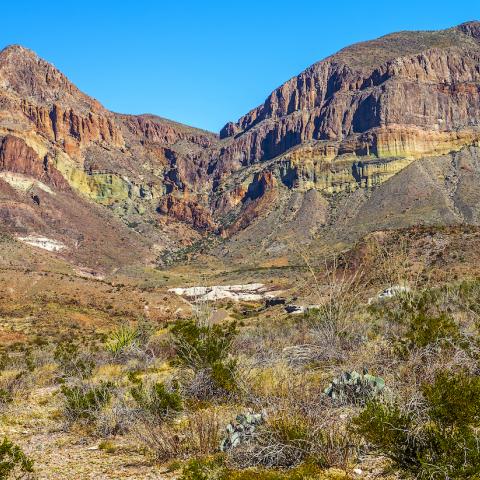
Moonlight Over The Window At Big Bend National Park / Rebecca Latson
While I have not visited every single U.S. national park, I have visited a number of them. One of my favorite parks among those visited is Big Bend National Park in Texas. I have returned to this park more than any other, although that might have something to do with it being located in the state in which I currently live, despite the fact that it’s out in the middle of nowhere.
When offered a seat at the Big Bend Conservancy's Dark Sky Dinner on January 16, I jumped at the chance. This dinner would be a “…signature Centennial event celebrating the National Park Service’s 100th Birthday,” as quoted from the Dark Sky Dinner flyer.

Dark Sky Dinner Program, Big Bend National Park / Rebecca Latson
In 2012, the International Dark Sky Association awarded this national park with a Gold Tier status, representing a sky free of “all but the most minor impacts of light pollution.” The combination of low humidity and little-to-no light or air pollution makes Big Bend National Park a perfect setting for star gazing, even with the moon at first quarter as it was on the 16th. All of this, in turn, makes it ideal for capturing some night sky photography.

Starry Night Over Dog Canyon, Big Bend National Park / Rebecca Latson
I departed for the park a couple of days prior to the dinner, flying from Houston to Midland then driving the two-plus hours to Marathon, located 70 miles north of the park’s Persimmon Gap entrance. The last two times I visited Big Bend, I drove my own car from home for a total of 13 hours, one way, from one end of the state to the other, basically. Arriving at Marathon, I stayed a couple of nights before transferring myself, camera gear, and luggage to the Chisos Mountains Lodge for that evening’s dinner. The lodge is the only brick-and-mortar accommodation within this vast park and one must make reservations months ahead of time to be guaranteed a room.
As part of the events surrounding the dinner, the Big Bend Conservancy offered several days of activities: an astrophotography demonstration hosted by TJ Avery of Thomas J. Avery Photography, a Grapevine Hills hike hosted by David Elkowitz, the park's chief of interpretation and visitor services, and a viewing of solar spots and flares offered by astronomer Phil Kelton, former superintendent of McDonald Observatory, using his hydrogen-alpha solar telescope (it was very cool to see solar flares through that scope).

Viewing Sunspots and Solar Flares Through A Telescope, Big Bend National Park / Rebecca Latson
Cocktails were served on the Chisos Mountains Lodge restaurant patio while the dinner, itself, was held in the lodge’s restaurant. A huge shout-out goes to the staff of Forever Resorts and the Chisos Mountains Lodge, whose hard work turned the restaurant into a starry night-decorated banquet hall accommodating 134 dinner attendees, each enjoying a meal of appetizer, salad, entrée, and dessert.
Notable guests and speakers included Board President Ann Kovich, Big Bend National Park Superintendent Cindy Ott-Jones, U.S. Representative for the Texas 23rd congressional district, Congressman William “Will” Hurd, chief engineer for the Solar System Exploration Directorate at the Jet Propulsion Laboratory (as well as science fiction author) B. Gentry Lee, retired Captain USN and NASA astronaut Dominic Gorie, and aforementioned astronomer Phil Kelton.

Listening to B. Gentry Lee at the Dark Sky Dinner, Big Bend National Park / Rebecca Latson
The host, B. Gentry Lee, and the panelists Dominic Gorie and Phil Kelton, each spoke a bit about why they appreciated Big Bend National Park and the ideals behind the Dark Sky Dinner. They then took questions from the audience, ranging from how to use the toilet in zero gravity to the possibility of intelligent life within the universe to the importance of teaching children K through 12 an appreciation of the universe and the limitless opportunities afforded to them via the study of natural and earth science and astronomy.
To paraphrase B. Gentry Lee: “The stars are our parents; we are all made of the stuff of stars. In our bodies are the same chemical elements as those which created the universe…”

Starry Sky And Rising Sun Over the Fossil Exhibit At Big Bend National Park / Rebecca Latson
I asked Big Bend Conservancy Executive Director Courtney Lyons-Garcia how many years this dinner had been hosted and she grinned, saying this dinner was the very first one to be offered here within the park. After all was said and done, I’d say the dinner was a huge success and my congratulations to Ms. Lyons-Garcia and everybody who helped with this event.
Upon the conclusion of the dinner, the guests were invited outside for a little star gazing through some very nice telescopes set up across the road from the restaurant. I not only looked telescopically at the stars, but also photographically, having brought out my tripod, cameras and flashlight. During that particular night, I almost could have ditched the flashlight in favor of utilizing the moonlight to guide my steps. Not even the moon, though, could diminish the clarity of the starry sky.

Starry Sky Over Casa Grande And The Chisos Mountain Lodge Restaurant, Big Bend National Park / Rebecca Latson

Star Gazing Under A Night Sky, Big Bend National Park / Rebecca Latson
If you ever have the chance to visit Big Bend or some other national park on a clear night, far away from the lights of a city or town, and you happen to have your camera handy, then make a point of practicing your night sky photography. Some cameras have a setting for night photos, but I much prefer to use the manual settings.
- Place your camera on a tripod.
- Use the widest-angle lens you can. For the night sky shots in this article, I utilized my 11-24mm lens at both the 11 and the 24mm focal lengths.
- Play around with an ISO setting anywhere from 3200 to 6400.
- Open up your lens aperture as wide as you can, anywhere from f4 (wide) to f3.2 (wider) to f2.8 or more (widest), depending upon the lens (the wider the aperture, the smaller the f-stop number).
- Set your lens to MF (manual focus) rather than AF (auto focus). Because it’s dark, your lens will be searching and searching to try and find something – anything – upon which to focus if left in AF. This is the reason you manually set your lens to Infinity (that little sideways figure-eight symbol). Actually, you set the focus ring to right at infinity, and not all the way to beyond infinity (otherwise, your image will be totally blurred). Practice with this during the day, so you can get a feel for it.
- Play around with your shutter speed (15, 20, 25, 30 seconds). If you use anything longer than that (that’s called “bulb” and your SLR will have a setting for that), your images will start displaying those round star trails (they make me a little dizzy if I look at them for too long, believe it or not).
- Remember to use noise-reducing software when you edit the photos, otherwise your shots will look quite grainy, with little bits of green and pink dotting your image. That’s called “noise” and is a representation of visual distortion as a result of using a high ISO when photographing under low-light circumstances.
Oh, and here's a final bit of advice: While you are photographing the vast night sky canvas, please don’t forget to take your eye away from the viewfinder from time to time, drink in the view and enjoy the moment.

The Road To Persimmon Gap, Big Bend National Park / Rebecca Latson




 Support Essential Coverage of Essential Places
Support Essential Coverage of Essential Places







Comments
Very nicely done
I hae an interest to come to the park for the night sky adventure and see everything i can see, thanks for your insight and information.
My heart soars when I see pictures like this...I think indeed it recognizes and connects with the matter we're made from.
I regret I didn't find Big Bend sooner when I could have actually physically enjoyed it. Thanks for sharing.